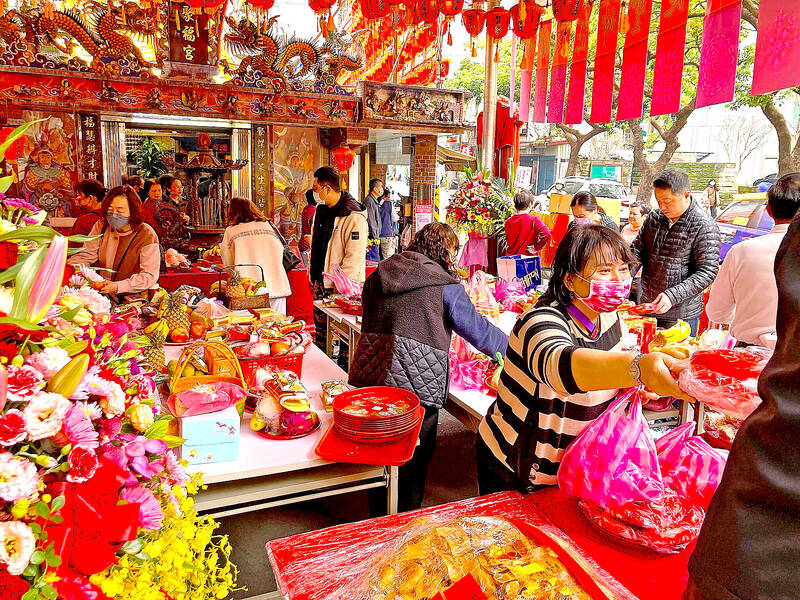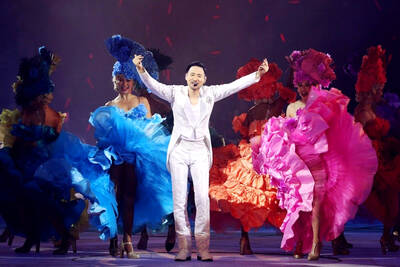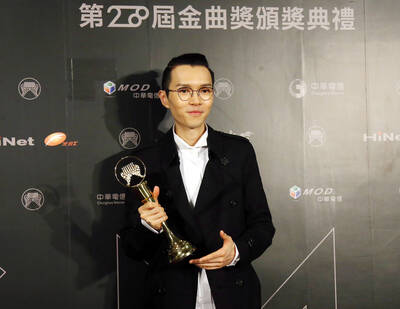對話 Dialogue
清清:你買這麼多吃的幹嘛?過年的都還沒吃完呢!
Qīngqing: Nǐ mǎi zhème duō chī de gànmá? Guònián de dōu háiméi chīwán ne!

Photo courtesy of Wikimedia Commons / 照片:Wikimedia Commons提供
華華:農曆二月初二是土地公的生日,也是「頭牙」,拜好土地公,才會好運到、發大財啊!
Huáhua: Nónglì èr yuè chūèr shì Tǔdìgōng de shēngrì, yěshì “tóuyá”', bàihǎo Tǔdìgōng, cái huì hǎoyùn dào, fā dàcái a!
清清:我都忘了!難怪你買了麻糬、發糕和糖果,聽說土地公愛吃甜的。
Qīngqing: Wǒ dōu wàngle! Nánguài nǐ mǎile máshǔ, fāgāo hàn tángguǒ, tīngshuō Tǔdìgōng ài chī tiánde.
華華:還有這個酒,可以拜米酒或是啤酒。不想拜酒,用花生湯、仙草蜜也可以。
Huáhua: Háiyǒu zhèige jiǔ, kěyǐ bài mǐjiǔ huòshì píjiǔ. Bùxiǎng bài jiǔ, yòng huāshēng tāng, xiāncǎomì yě kěyǐ
清清:還好土地公公是神明,吃這麼甜,不怕會得糖尿病。
Qīngqing: Háihǎo Tǔdìgōnggong shì shénmíng, chī zhème tián, búpà huì dé tángniàobìng.
華華:不要亂講話啦!不可以對神明不敬!
Huáhua: Búyào luàn jiǎnghuà la! Bù kěyǐ duì shénmíng bújìng!
清清:我還聽說土地公特別喜歡吃花生,你準備了沒有?
Qīngqing: Wǒ hái tīngshuō Tǔdìgōng tèbié xǐhuān chī huāshēng, nǐ zhǔnbèi le méiyǒu?
華華:當然啦!你看這一大包花生糖,保佑我這一年甜甜蜜蜜的好事一直發生喔!
Huáhua: Dāngrán la! Nǐ kàn zhè yí dà bāo huāshēng táng, bǎoyòu wǒ zhè yì nián tián tiánmìmì de hǎoshì yìzhí fāshēng ō!
翻譯 Translation
Qingqing: Why did you buy so much food? We haven’t finished the New Year’s food yet!
Huahua: The 2nd day of the 2nd lunar month is the Earth God’s birthday, also known as “Touya.” Honoring him brings good luck and prosperity.
Qingqing: I totally forgot. No wonder you bought mochi, steamed rice cake and candy. I heard the Earth God likes sweets.
Huahua: And this wine, you can use rice wine or beer for the offering. If you don’t want to use alcohol, peanut soup or grass jelly can work too.
Qingqing: Luckily, the Earth God is a deity, so eating all this sweetness doesn’t give him diabetes.
Huahua: Watch your mouth! You can’t be disrespectful to deities.
Qingqing: I also heard the Earth God especially likes peanuts. Did you prepare them?
Huahua: Of course. Look at this big bag of peanut candy—hoping for a sweet and lucky year.
生詞 Vocabulary
1. 土地公 (Tǔdìgōng) Earth God, God of the Land
2. 農曆 (nónglì) lunar calendar
3. 頭牙 (tóuyá) Head of the Year
4. 發糕 (fāgāo) steamed sponge cake (symbolizing prosperity and good luck)
5. 仙草蜜 (xiāncǎomì) grass jelly, herbal jelly
6. 神明 (shénmíng) deity, god or goodess
7. 糖尿病 (tángniàobìng) diabetes
8. 亂講話 (luàn jiǎnghuà) shoot off one’s mouth
教材音檔 Audio Files
國立清華大學華語中心提供
By National Tsing Hua University Chinese Language Center:

Even as he grows older, Microsoft founder Bill Gates still fondly remembers the catalytic computer code he wrote 50 years ago that opened up a new frontier in technology. Although the code that Gates printed out on a teletype machine may look crude compared to what’s powering today’s artificial intelligence platforms, it played a critical role in creating Microsoft in April 1975 — a golden anniversary that the Redmond, Washington, company celebrated on April 4. Gates, 69, set the stage for that jubilee with a blog post reminiscing on how he and his old high school friend — the late Paul Allen

Australia’s strict immigration policies have long been criticized, particularly for how they treat people with disabilities. Having been residents of Australia for years, Scottish Laura Currie and her Italian partner, Dante Vendittelli, recently experienced the impact of these immigration policies. Their son Luca, born in Australia and diagnosed with cystic fibrosis, became the reason their residency application was denied due to the anticipated high healthcare costs. Had Luca been healthy, there would have been no objections to their permanent residency. This case not only highlights discrimination against disabled individuals, but also raises questions about fairness and inclusion within Australia’s immigration

A: After holding nine concerts in Kaohsiung and Taipei recently, “God of Songs” Jacky Cheung will stage three extra shows later this week. B: They’re compensation for the three shows he postponed last year due to illness. A: He also canceled three more shows in Guangzhou last month. His health is worrisome. B: When touring Guangzhou, he dedicated his hit “She Is Far Away” to late singer Khalil Fong. That’s so touching. A: Online music platform KKBOX has also launched a campaign to pay tribute to Fong. I can’t believe he died so young: he was only 41. A:

A: After “God of Songs” Jacky Cheung sang for late singer Khalil Fong recently, music streaming service KKBOX also paid tribute to Fong by releasing his greatest hits online. B: The 20th KKBOX Music Awards ceremony is taking place at the K-Arena in Kaohsiung tomorrow. Fong performed at the ceremonies in the past. A: Who are the performers this year? B: The performers include Taiwanese groups 911, Wolf(s), Ozone, Singaporean pop diva Tanya Chua, and K-pop group Super Junior. A: South Korean stars actually took four spots among KKBOX’s 2024 Top 10 singles, showing that K-pop is still